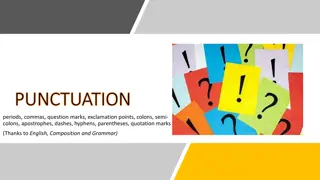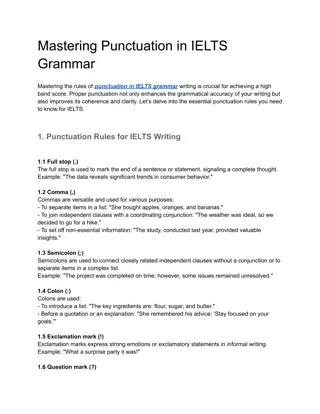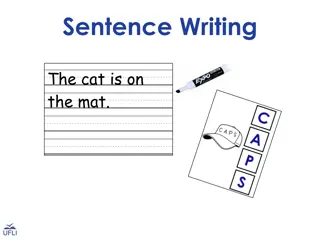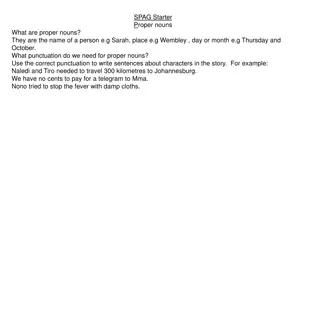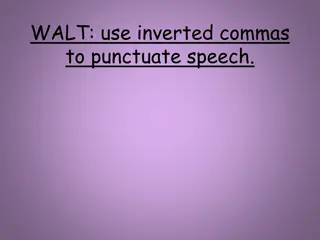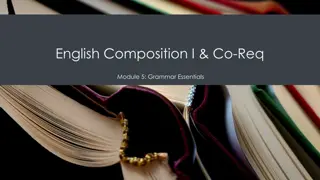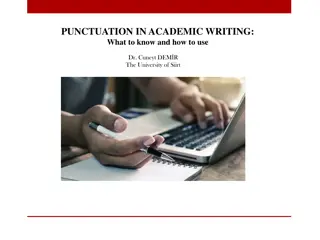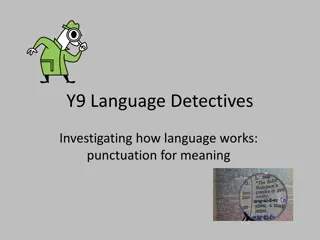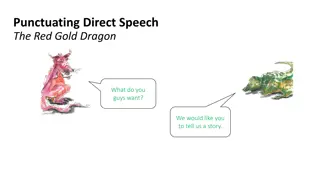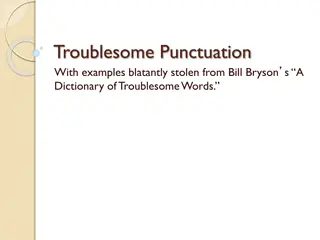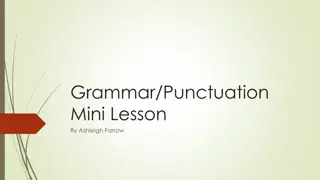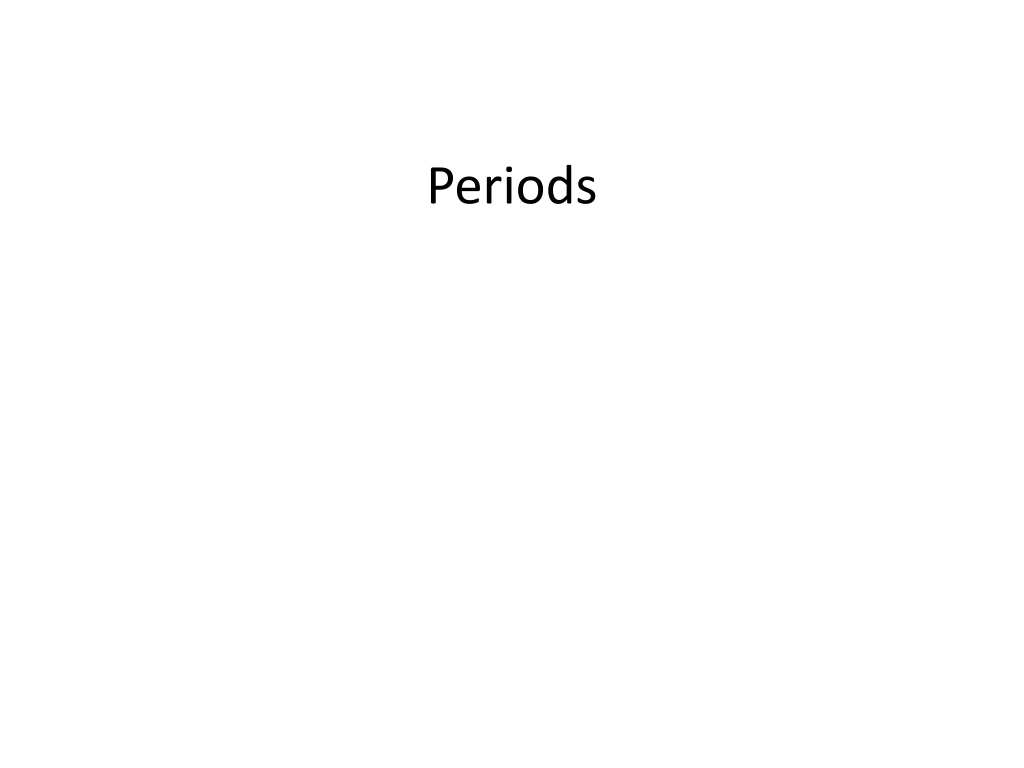
Writing Rules: Proper Use of Periods and Commas
Learn the rules for using periods and commas correctly in your sentences. Understand when to use a period at the end of a statement and when to include or omit a comma in various scenarios. Master the art of punctuation for clear and effective writing.
Download Presentation

Please find below an Image/Link to download the presentation.
The content on the website is provided AS IS for your information and personal use only. It may not be sold, licensed, or shared on other websites without obtaining consent from the author. Download presentation by click this link. If you encounter any issues during the download, it is possible that the publisher has removed the file from their server.
E N D
Presentation Transcript
Rule 1. Use a period at the end of a complete sentence that is a statement. Example: I know him well.
Rule 2. If the last item in the sentence is an abbreviation that ends in a period, do not follow it with another period. Incorrect: This is Alice Smith, M.D.. Correct: This is Alice Smith, M.D. Correct: Please shop, cook, etc. We will do the laundry.
Commas Rule 1. Use commas to separate words and word groups in a simple series of three or more items. Example: My estate goes to my husband, son, daughter-in-law, and nephew. Note: When the last comma in a series comes before and or or (after daughter-in-law in the above example), it is known as the Oxford comma. Most newspapers and magazines drop the Oxford comma in a simple series, apparently feeling it's unnecessary. However, omission of the Oxford comma can sometimes lead to misunderstandings.
Rule 2. Use a comma to separate two adjectives when the adjectives are interchangeable. Example: He is a strong, healthy man. We could also say healthy, strong man. Example: We stayed at an expensive summer resort. We would not say summer expensive resort, so no comma.
Rule 3a. Many inexperienced writers run two independent clauses together by using a comma instead of a period. This results in the dreaded run-on sentence or, more technically, a comma splice. Incorrect: He walked all the way home, he shut the door. There are several simple remedies: Correct: He walked all the way home. He shut the door. Correct: After he walked all the way home, he shut the door. Correct: He walked all the way home, and he shut the door.
Rule 3b. In sentences where two independent clauses are joined by connectors such asand, or, but, etc., put a comma at the end of the first clause. Incorrect: He walked all the way home and he shut the door. Correct: He walked all the way home, and he shut the door. Some writers omit the comma if the clauses are both quite short: Example: I paint and he writes.
Rule 3c. If the subject does not appear in front of the second verb, a comma is generally unnecessary. Example: He thought quickly but still did not answer correctly.
Rule 4a. Use a comma after certain words that introduce a sentence, such as well, yes, why, hello, hey, etc. Examples: Why, I can't believe this! No, you can't have a dollar.
Rule 4b. Use commas to set off expressions that interrupt the sentence flow (nevertheless, after all, by the way, on the other hand, however, etc.). Example: I am, by the way, very nervous about this.
Rule 5. Use commas to set off the name, nickname, term of endearment, or title of a person directly addressed. Examples: Will you, Aisha, do that assignment for me? Yes, old friend, I will. Good day, Captain.
Rule 6. Use a comma to separate the day of the month from the year, and what most people forget! always put one after the year, also. Example: It was in the Sun's June 5, 2003, edition. No comma is necessary for just the month and year. Example: It was in a June 2003 article.
Rule 7. Use a comma to separate a city from its state, and remember to put one after the state, also. Example: I'm from the Akron, Ohio, area.
Rule 8. Traditionally, if a person's name is followed by Sr. or Jr., a comma follows the last name: Martin Luther King, Jr. This comma is no longer considered mandatory. However, if a comma does precede Sr. or Jr., another comma must follow the entire name when it appears midsentence. Correct: Al Mooney Sr. is here. Correct: Al Mooney, Sr., is here. Incorrect: Al Mooney, Sr. is here.
Rule 9. Similarly, use commas to enclose degrees or titles used with names. Example: Al Mooney, M.D., is here.
Rule 10. When starting a sentence with a dependent clause, use a comma after it. Example: If you are not sure about this, let me know now. But often a comma is unnecessary when the sentence starts with an independent clause followed by a dependent clause. Example: Let me know now if you are not sure about this.
Rule 11. Use commas to set off nonessential words, clauses, and phrases (see the "Who, That, Which" section in Chapter One, Rule 2b). Incorrect: Jill who is my sister shut the door. Correct: Jill, who is my sister, shut the door. Incorrect: The man knowing it was late hurried home. Correct: The man, knowing it was late, hurried home.
Rule 13a. Use commas to introduce or interrupt direct quotations. Examples: He said, "I don't care." "Why," I asked, "don't you care?"
Rule 13b. If the quotation comes before he said, she wrote, they reported, Dana insisted, or a similar attribution, end the quoted material with a comma, even if it is only one word. Examples: "I don't care," he said. "Stop," he said.
Rule 14. Use a comma to separate a statement from a question. Example: I can go, can't I?
Rule 15. Use a comma to separate contrasting parts of a sentence. Example: That is my money, not yours.
Rule 16a. Use a comma before and after certain introductory words or terms, such as namely, that is, i.e., e.g., and for instance, when they are followed by a series of items. Example: You may be required to bring many items, e.g., sleeping bags, pans, and warm clothing.
Rule 16a. Commas should precede the term etc. and enclose it if it is placed midsentence. Example: Sleeping bags, pans, warm clothing, etc., are in the tent.
Semicolons ; Rule 1. A semicolon can replace a period if the writer wishes to narrow the gap between two closely linked sentences. Examples: Call me tomorrow; you can give me an answer then. We have paid our dues; we expect all the privileges listed in the contract.
Rule 2. Use a semicolon before such words and terms as namely, however, therefore, that is, i.e., for example, e.g., for instance, etc., when they introduce a complete sentence. It is also preferable to use a comma after these words and terms. Example: Bring any two items; however, sleeping bags and tents are in short supply.
Rule 3. Use a semicolon to separate units of a series when one or more of the units contain commas. Incorrect: The conference has people who have come from Moscow, Idaho, Springfield, California, Alamo, Tennessee, and other places as well. Note that with only commas, that sentence is hopeless. Correct: The conference has people who have come from Moscow, Idaho; Springfield, California; Alamo, Tennessee; and other places as well
Rule 4. A semicolon may be used between independent clauses joined by a connector, such as and, but, or, nor, etc., when one or more commas appear in the first clause. Example: When I finish here, and I will soon, I'll be glad to help you; and that is a promise I will keep.
Colons : Rule 1. Use a colon to introduce a series of items. Do not capitalize the first item after the colon (unless it's a proper noun). Examples: You may be required to bring many things: sleeping bags, pans, utensils, and warm clothing. I want the following items: butter, sugar, and flour. I need an assistant who can do the following: input data, write reports, and complete tax forms.
Rule 2. Avoid using a colon before a list when it directly follows a verb or preposition. Incorrect: I want: butter, sugar, and flour. Correct: I want the following: butter, sugar, and flour. OR I want butter, sugar, and flour.
Rule 3. When listing items one by one, one per line, following a colon, capitalization and ending punctuation are optional when using single words or phrases preceded by letters, numbers, or bullet points. If each point is a complete sentence, capitalize the first word and end the sentence with appropriate ending punctuation. Otherwise, there are no hard and fast rules, except be consistent. Examples: I want an assistant who can do the following: input data write reports complete tax forms
Rule 4. A colon instead of a semicolon may be used between independent clauses when the second sentence explains, illustrates, paraphrases, or expands on the first sentence. Example: He got what he worked for: he really earned that promotion.
Rule 5. A colon may be used to introduce a long quotation. Some style manuals say to indent one-half inch on both the left and right margins; others say to indent only on the left margin. Quotation marks are not used. Example: The author of Touched, Jane Straus, wrote in the first chapter: Georgia went back to her bed and stared at the intricate patterns of burned moth wings in the translucent glass of the overhead light. Her father was in "hyper mode" again where nothing could calm him down.
Rule 6. Use a colon rather than a comma to follow the salutation in a business letter, even when addressing someone by his or her first name. (Never use a semicolon after a salutation.) A comma is used after the salutation in more informal correspondence. Formal: Dear Ms. Rodriguez: Informal: Dear Dave,
Quotation Marks Rule 1. Use double quotation marks to set off a direct (word-for-word) quotation. Correct: "When will you be here?" he asked. Incorrect: He asked "when I would be there."
Rule 2. Either quotation marks or italics are customary for titles: magazines, books, plays, films, songs, poems, article titles, chapter titles, etc.
Rule 3a. Periods and commas always go inside quotation marks. Examples: The sign said, "Walk." Then it said, "Don't Walk," then, "Walk," all within thirty seconds. He yelled, "Hurry up."
Rule 3b. Use single quotation marks for quotations within quotations. Example: He said, "Dan cried, 'Do not treat me that way.' "
Rule 4. As a courtesy, make sure there is visible space at the start or end of a quotation between adjacent single and double quotation marks. (Your word processing program may do this automatically.) Not ample space: He said, "Dan cried, 'Do not treat me that way.'" Ample space: He said, "Dan cried, 'Do not treat me that way.' "
Rule 5a. Quotation marks are often used with technical terms, terms used in an unusual way, or other expressions that vary from standard usage. Examples: It's an oil-extraction method known as "fracking." He did some "experimenting" in his college days. I had a visit from my "friend" the tax man.
Rule 5b. Never use single quotation marks in sentences like the previous three. Incorrect: I had a visit from my 'friend' the tax man. The single quotation marks in the above sentence are intended to send a message to the reader that friend is being used in a special way: in this case, sarcastically. Avoid this invalid usage. Single quotation marks are valid only within a quotation, as per Rule 3b, above.
Rule 6. When quoted material runs more than one paragraph, start each new paragraph with opening quotation marks, but do not use closing quotation marks until the end of the passage. Example: She wrote: "I don't paint anymore. For a while I thought it was just a phase that I'd get over. "Now, I don't even try."
Parentheses () Rule 1. Use parentheses to enclose information that clarifies or is used as an aside. Example: He finally answered (after taking five minutes to think) that he did not understand the question.
Rule 2. Periods go inside parentheses only if an entire sentence is inside the parentheses. Example: Please read the analysis. (You'll be amazed.)
Rule 3. Parentheses, despite appearances, are not part of the subject. Example: Joe (and his trusty mutt) was always welcome.
Rule 4. Commas are more likely to follow parentheses than precede them. Incorrect: When he got home, (it was already dark outside) he fixed dinner. Correct: When he got home (it was already dark outside), he fixed dinner.
Brackets [] Rule 1. Brackets are interruptions. When we see them, we know they've been added by someone else. They are used to explain or comment on the quotation. Examples: "Four score and seven [today we'd say eighty- seven] years ago..." "Bill shook hands with [his son] Al."
Rule 2. When quoting something that has a spelling or grammar mistake or presents material in a confusing way, insert the term sic in italics and enclose it in nonitalic (unless the surrounding text is italic) brackets. Sic ("thus" in Latin) is shorthand for, "This is exactly what the original material says." Example: She wrote, "I would rather die then [sic] be seen wearing the same outfit as my sister."
Rule 1a. Use the apostrophe to show possession. To show possession with a singular noun, add an apostrophe plus the letter s. Examples: a woman's hat the boss's wife Mrs. Chang's house
Rule 2a. Regular nouns are nouns that form their plurals by adding either the letter s or -es(guy, guys; letter, letters; actress, actresses; etc.). To show plural possession, simply put an apostrophe after the s. Correct: guys' night out (guy + s + apostrophe) Incorrect: guy's night out (implies only one guy) Correct: two actresses' roles (actress + es + apostrophe) Incorrect: two actress's roles
Rule 2e. Never use an apostrophe to make a name plural. Incorrect: The Wilson's are here. Correct: The Wilsons are here. Incorrect: We visited the Sanchez's. Correct: We visited the Sanchezes.


